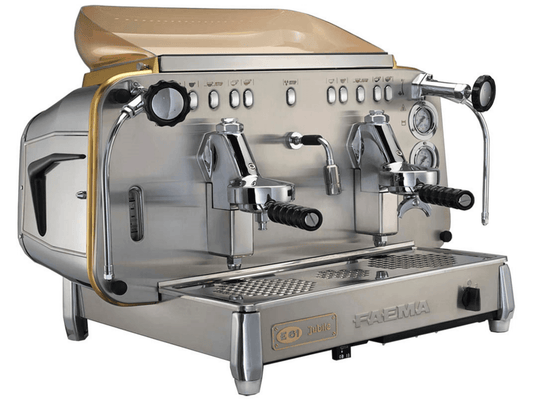SHOP BY machine TYPE
SHOP BY boiler type

Your wishlist is empty.
Black Friday Deals up to 40% off -
SHOP COMMERCIAL |
SHOP HOME
Explore Our Handpicked Coffee Equipment -
for Home | for Commercial
Get Monthly Offers & Discounts - 5% off Now
Sign Me Up
SHOP BY machine TYPE
SHOP BY boiler type

Espresso machines
SHOP BY machine TYPE
SHOP BY boiler type
Renewed Machines
SHOP BY machine TYPE
SHOP BY boiler type
Accessories
Best Bundles
Fast Shipping
Espresso machines
Accessories
Best Bundles
Fast Shipping
At Pro Coffee Gear, we have a wide array of heat exchanger espresso machines to choose from. Whether you’re looking for compact and affordable 110v compact units for a coffee cart, or high-end workhorse for café use, we’ve got you covered.
We’re
expert generalists - meaning we deeply understand the nuances of nearly
every espresso machine brand inside and out. We use this knowledge to
help you find the perfect espresso machine for you across the wide range
of brands that we carry. Names like Wega, SanRemo, La Cimbali, Rocket Espresso, and many more. Get in touch
with our team of specialists to find the right machine for you. We have
a lot of expertise to share and look forward to helping you on your
journey.
Think of it this way, heat exchangers transfer (and thus, exchange) temperature from one fluid to another without these two fluids having to come into contact with each other. With heat exchanger espresso machines, brew water is pumped through a copper pipe that travels through the steam boiler and is heated. This water then circulates through the group head of the espresso machine and back down to the bottom of the heat exchange. This motion is known as a thermosyphon. While not every type of heat exchange operates precisely in this way, the basic concept is the same. Heat Exchange espresso machines heat water for your espresso by circulating water through a pipe that’s in the steam boiler. When you make espresso, the machine mixes cold water from the bottom of the exchange with hot water in the top of the exchange to create an approximate brew temperature for your coffee. Meanwhile, steam is pulled directly from the boiler; this enables you to brew espresso and steam milk simultaneously.
Dual Boiler machines have separate boilers for brewing and steaming, ensuring consistent temperature control for each process. They are less likely to experience temperature fluctuations, making them ideal for high-volume cafes. However, they are more expensive and larger in size compared to heat exchanger machines.
Heat Exchanger espresso machines can be ideal for cafés and coffee shops that aren’t as concerned about varying brew temperatures and want to save a couple hundred dollars. Meanwhile, Dual Boilers are for establishments that prioritize shot consistency with the ability to adjust brew temperatures.
Pros
Cons
Expected to ship by November 24
Usually ships within 5 business days
Classe 5 S Compact
Rancilio
Usually ships within 2-3 business days
Pratic Avant Xtra SAE 1 Group
Astoria
Usually ships within 4-5 business days
Usually ships within 4-5 business days
M26 TE RE
La Cimbali
Usually ships within 4-5 business days
80E 3 Group Chrome
La San Marco
Usually ships within 5 business days
100E 2 Group Silver
La San Marco
Usually ships within 15 days
At Pro Coffee Gear, we have a wide array of heat exchanger espresso machines to choose from. Whether you’re looking for compact and affordable 110v compact units for a coffee cart, or high-end workhorse for café use, we’ve got you covered.
We’re
expert generalists - meaning we deeply understand the nuances of nearly
every espresso machine brand inside and out. We use this knowledge to
help you find the perfect espresso machine for you across the wide range
of brands that we carry. Names like Wega, SanRemo, La Cimbali, Rocket Espresso, and many more. Get in touch
with our team of specialists to find the right machine for you. We have
a lot of expertise to share and look forward to helping you on your
journey.
Think of it this way, heat exchangers transfer (and thus, exchange) temperature from one fluid to another without these two fluids having to come into contact with each other. With heat exchanger espresso machines, brew water is pumped through a copper pipe that travels through the steam boiler and is heated. This water then circulates through the group head of the espresso machine and back down to the bottom of the heat exchange. This motion is known as a thermosyphon. While not every type of heat exchange operates precisely in this way, the basic concept is the same. Heat Exchange espresso machines heat water for your espresso by circulating water through a pipe that’s in the steam boiler. When you make espresso, the machine mixes cold water from the bottom of the exchange with hot water in the top of the exchange to create an approximate brew temperature for your coffee. Meanwhile, steam is pulled directly from the boiler; this enables you to brew espresso and steam milk simultaneously.
Dual Boiler machines have separate boilers for brewing and steaming, ensuring consistent temperature control for each process. They are less likely to experience temperature fluctuations, making them ideal for high-volume cafes. However, they are more expensive and larger in size compared to heat exchanger machines.
Heat Exchanger espresso machines can be ideal for cafés and coffee shops that aren’t as concerned about varying brew temperatures and want to save a couple hundred dollars. Meanwhile, Dual Boilers are for establishments that prioritize shot consistency with the ability to adjust brew temperatures.
Pros
Cons
Sign up and get 5% off first order
Sign up for our newsletter to keep up with new products, events and 5% off your first order!









